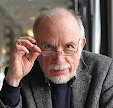(Translation of the story "Nicht sein Tod" from "Begegnungen mit dem Leibhaftigen", Tredition 2016)
The bell rang at the door of the former medical practice. Two younger people were outside, a man and a woman. Somebody had collapsed on the street, they asked for the doctor. The doctor was retired, but he was still living here.
What
follows in the next section took place within 30 seconds: The old doctor went
out through the front yard onto the sidewalk. There was a small group of people
standing around someone who was lying on the ground, face down, a small figure
in a shabby suit. A trail of fluid ran from his trousers against the gutter. He
had probably lost urine, perhaps in an epileptic seizure. Or he was in cardiac
arrest. The doctor knelt down, turned the face of the person towards him, it
was a little bluish. Then a grip in his trouser pockets, he found a purse with
an identity card, born in 1923. It was 2010, so the man was 87 years old. At
this age, street-resuscitation does not make sense in the event of cardiac
arrest. Even if successful, people are almost always permanently impaired and
require long term care. One should leave them alone. Still, the doctor wanted to know what was
going on, looked for the pulse on the wrists, on the neck, it had no pulse
anywhere. Cardiac arrest. He got up again, turned to the bystanders and
explained – as a kind old Uncle Doctor - that this was cardiac arrest. That the
man was 87 years old. And that at this age resuscitation made no sense because
the results were practically always catastrophic.
The siren
of an ambulance sounded very softly through the air, someone had already called
with the handy. The doctor still wanted to say that it would be better to give
the old man his rest, so it would be a beautiful and painless death. But the
siren was loud now and the ambulance was already turning into the side street,
bright yellow, highly polished and flashing blue, approaching quickly and then
coming to a sharp stop next to our group of people.
Two paramedics, a middle-aged man and a younger blonde woman with an emergency kit jumped out, both athletic and in top form, both in sparkling yellow luminous vests. They quickly made sure that the phone was made from here, rushed to the man lying on the floor, grabbed the pulses that they couldn't find either. The young woman began pumping his chest to reanimate him. The old doctor would have liked to stop them, but they were in the uniform of law enforcement and all those standing by could not even know whether he was a doctor. So he kept quiet. The paramedic dragged the defibrillator on, while the woman continued to pump, he opened the shirt, exposed the chest and stuck the electrodes on. The screen showed no regular heart action, so the electric shock was delivered. After that, no effect. Another shock, now the screen showed a heart action again, irregular, but at least he had an irregular pulse and turned a little pink, but remained unconscious. The woman disappeared into the ambulance and came back with a stretcher and an infusion bottle. The old man was placed on the stretcher, the IV placed in a vein in his arm. Then the old man was carried to the ambulance by the two of them, the young woman stayed with the patient, the man quickly closed the rear door, gave a brief greeting, climbed into the driver's seat and away they roared with flashing lights and the siren got quieter and quieter. The whole haunt might have lasted three minutes.
Yes, this
whole performance had been extremely professional and virtuosic. Such quality
and speed can only be achieved with constant practice. At the same time, the
staging had something synthetically unreal about it: the paramedics looked like
shiny Lego men who functioned with their Lego ambulance in a perfect Lego
world. Or like computer animations in those American films in which all
surfaces are imitated so perfectly - virtual reality - and yet everything
remains unreal.
For this perfect Lego world, this shabby old little man was the wrong object. He obviously had been independent so far. And now in very old age his life wanted to come to an end. His luck would have benn to meet a death that had everything one could want from death: sudden, peaceful, and painless.
But they
took his death away, postponed his death into care dependency, to a nursing
home. Was that what this man wanted? Would we have that wish? Does our health
budget have enough money to pay for such idle pastimes?
If this old
man were an isolated case it could be ignored. But he is not an isolated case.
His case is the expression of a general
philosophy. The old doctor remembers: At a young age he was trained in the internal medicine clinic, which was considered the
best at the time in his country. The directive there read: "Every cardiac
arrest has to reanimated because interns have to practice". The same
directive applies to paramedics, whether this makes sense on the given object
or not.
Nobody asks us…

